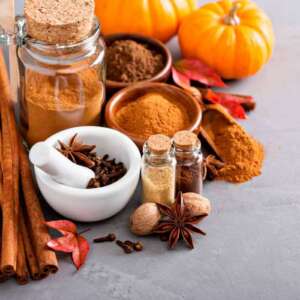
Well before Halloween commences, the pumpkin flavored brigade hits the store shelves and the smell of pumpkin spice fills the air. For those who are fans of this onslaught, it is pure heaven. For others, not so much. But pumpkin and pumpkin spice actually are very healthy and should not be overlooked or dismissed.
Pumpkin (Nan Gua) and pumpkin seeds (Nan Gua Zi) have been used in East Asian herbal medicine for thousands of years. Likewise, the components of pumpkin spice, ginger (Gan Jiang), nutmeg (Rou Dou Kou), clove (Ding Xiang) and cinnamon (Rou Gui), are also frequent players in East Asian herbal medicine. All of these foods have amazing benefits and can help with a ton of health issues.
1. Pumpkin (Nan Gua) and Pumpkin Seeds (Nan Gua Zi) – Used by almost every culture at some point in history, the pumpkin and its seeds provide many health benefits. In East Asian Medicine (EAM), both items can help to resolve dampness, expel parasites, relieve pain and more. Specific uses include dysentery, diarrhea, eczema, bladder infections, stomachaches, indigestion, hemorrhoids, intestinal worms, parasites, joint pain and swelling due to dampness. They also have been shown to improve lactation, fertility and postpartum fluid metabolism.
2. Ginger (Gan Jiang) – Renowned for its therapeutic properties in EAM, ginger is considered a warming spice that helps balance the spleen and stomach. During the fall, dampness can accumulate within the body, leading to digestive discomfort and fatigue. Ginger offers warmth and comfort to the digestive system, while promoting overall well-being. Ginger warms the lungs, expels phlegm, warms the center and expels cold.
3. Nutmeg (Rou Dou Kou) – Nutmeg enhances the flow of qi within the body, making it an ideal addition for the fall season. Nutmeg fortifies the body’s defensive qi aka the immune system, which is crucial for safeguarding against seasonal ailments. By incorporating nutmeg into pumpkin spice recipes, you’re not just infusing your dishes with a rich and aromatic flavor; you’re also strengthening your body’s natural defenses. Nutmeg warms the middle, moves qi, stops diarrhea and alleviates pain.
4. Clove (Ding Xiang) – Cloves resonate with the principles of EAM by their warming influence on the digestive system. As the fall season ushers in cooler weather, our bodies require a bit more inner heat to efficiently process the foods we consume. The inclusion of cloves in pumpkin spice not only enhances flavor but also aids in maintaining harmony within the body. Cloves warm the middle and direct rebellious qi downward, while warming the kidneys and boosting kidney yang.
5. Cinnamon (Rou Gui) – This spice is well-known for its warming properties in EAM. It is believed to enliven the body’s yang energy, associated with warmth and vitality. In the fall, as temperatures drop and the days grow shorter, our bodies naturally seek solace in warmth and comfort. Cinnamon steps in as the perfect companion, helping to dispel the chill in the air. Cinnamon fortifies the kidneys, spleen and heart. It warms the channels, disperses the cold and encourages the generation of qi and blood.
Pumpkin is full of vital nutrients like vitamin A and C, potassium and phosphorus. The seeds are a healthy form of fat, vitamin K, magnesium, manganese, zinc, copper and phosphorus. The components of pumpkin spice warm and fortify the digestion, boost the immune system and warm the channels which helps alleviate pain. Mixing all these yummy items together is a perfect way to help keep the body functioning during the cooler fall and colder winter months. But if you still need assistance, give us a call to set up an appointment and get back on track.

